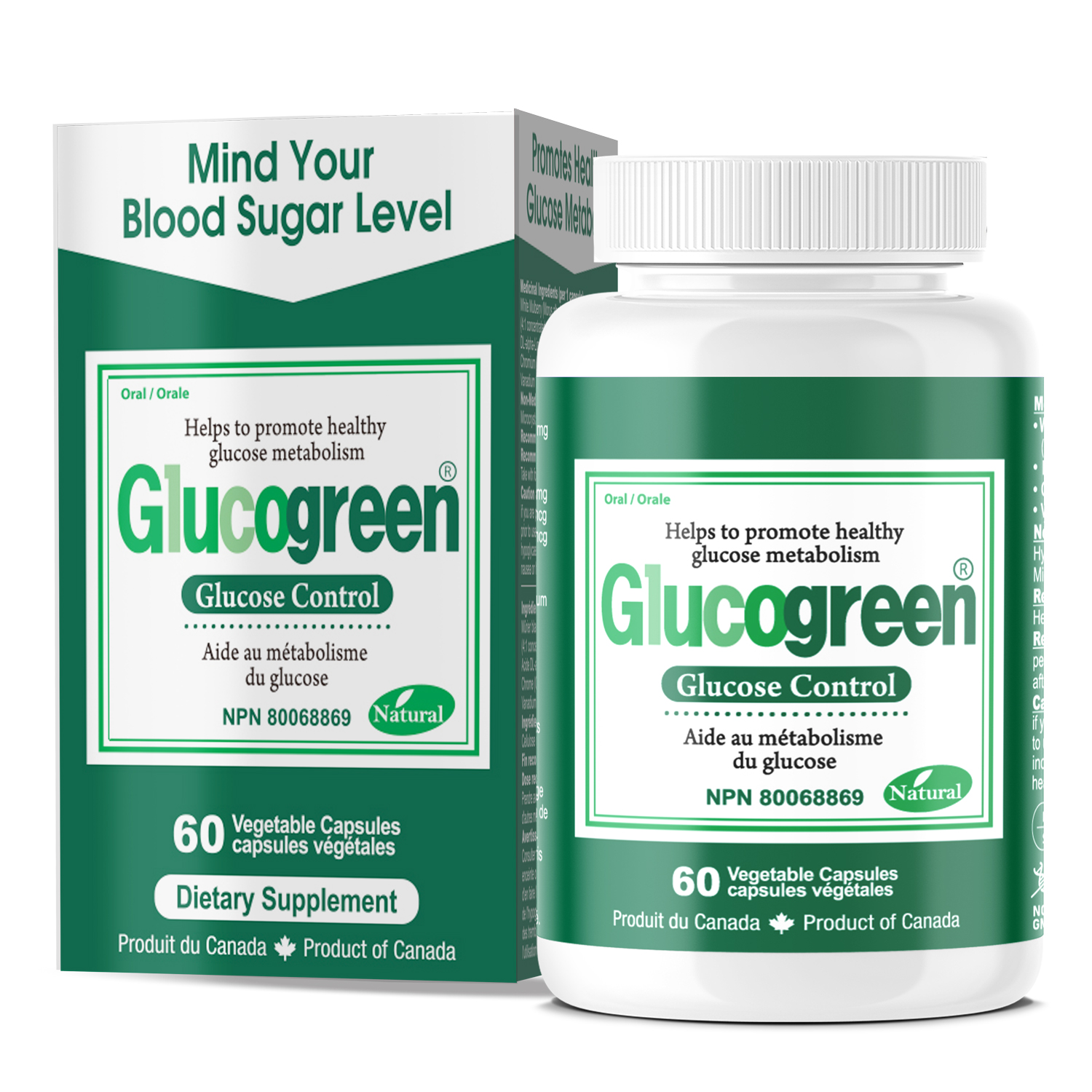Glucogreen Glucose Control 500mg 60 Vcaps
$0.00
Highlights
- Helps to promote healthy glucose metabolism
- Helps to maintain/support normal blood glucose levels.
- Powerful antioxidant activity
- Anti-inflammatory effects
- Helps to maintain/support the body's ability to metabolize nutrients
Description
Glucogreen (NPN 80068869), 60 Vcaps for healthy glucose control
PRODUCT RESEARCH / SAFETY
What is Glucose metabolism?
- Glucose is an essential simple sugar for maintaining normal body functions.
- When we consume carbohydrates, they are broken down into glucose during
digestion, which is then absorbed into the bloodstream. - Glucose metabolism involves the conversion of glucose into energy, storage of
glucose as glycogen, and the synthesis of other molecules. - Glucose metabolism is tightly regulated by various hormones, with insulin being a
key player.
White Mulberry (Morus alba)
- Various parts of the white mulberry tree, including leaves, fruits, and bark, have
been used for traditional medicine. - Mulberries are rich in phytonutrient compounds like essential vitamins, amino acids,
polysaccharide, fiber, lipid, and minerals including vitamin C, vitamin K, iron,
potassium, magnesium, and calcium (1). - 1-deoxynojirimycin (DNJ) is the main active ingredient related to glucose control
and diabetes management. DNJ can inhibit enzymes, intestinal α-glucosidases,
involved in carbohydrate digestion and may help prevent sharp spikes in blood sugar
levels after a meal (2).
DL-alpha-Lipoic acid (ALA)
- DL-alpha-lipoic acid (ALA) is a naturally occurring compound that acts as a
powerful antioxidant in the body (3). - DL-ALA is a racemic mixture containing both the R- and S- isomers of alpha-lipoic
acid and the S-isomer is considered biologically inactive. - Both DL-ALA and R-ALA can provide potential health benefits for antioxidant
activities, blood sugar control, and anti-inflammation properties (3). - DL-ALA helps to promote healthy glucose metabolism and to reduce oxidative
stress due to antioxidative effects (3).
Chromium
- Chromium is the present naturally in onions, tomatoes, oysters, whole grains, bran
cereals, and potatoes (4). - Chromium is an essential mineral that plays a critical role in insulin function and
glucose metabolism (5). - Some studies suggest that supplementing with chromium may help improve blood
sugar control, particularly in individuals with diabetes (6).
Vanadium
- Vanadium is a trace mineral obtained from mushrooms, shellfish, black pepper, and
parsley. - Vanadium is involved in glucose metabolism and insulin sensitivity (7).
- Vanadium may increase the action of insulin, but the potential mechanism of action
is uncertain (8). - Vanadium compounds can mimic actions of insulin through alternative signaling
pathways (9).
Key Benefits of Glucogreen
1. Blood sugar control
Mulberries contain 1-deoxynojirimycin (DNJ) and phytochemicals associated with
glucose metabolism and blood glucose level.
DL-alpha-Lipoic acid (ALA) can enhance glucose uptake by cells, increase insulin
sensitivity, and promote the efficient utilization of glucose in the body.
Chromium and Vanadium are essential minerals for glucose metabolism and
modulation of insulin-signaling pathways.
2. Enhanced Glucose Uptake
DL-ALA promotes the glucose transporter proteins, GLUT4, to the cell membrane.
These facilitates the uptake of glucose from the bloodstream into the cells, thereby
reducing blood sugar levels.
3. Powerful antioxidant activity
Mulberries are rich in antioxidants, including anthocyanins and flavonoids. These
compounds protect the cells from free radicals in the body, potentially reducing
inflammation. ALA possesses anti-inflammatory properties, which may help reduce
inflammation throughout the body.
REFERENCES
- Yuan, Q., & Zhao, L. (2017). The Mulberry (Morus alba L.) Fruit- A Review of Characteristic Components and Health Benefits. Journal of Agricultural and Food Chemistry, 65(48), 10383–10394.
- Gryn-Rynko, A., Bazylak, G., & Olszewska-Slonina, D. (2016). New potential phytotherapeutics obtained from white mulberry (Morus alba L.) leaves. Biomedicine & Pharmacotherapy, 84, 628–636.
- Capece U, Moffa S, Improta I, Di Giuseppe G, Nista EC, Cefalo CMA, Cinti F, Pontecorvi A, Gasbarrini A, Giaccari A, Mezza T. Alpha-Lipoic Acid and Glucose Metabolism: A Comprehensive Update on Biochemical and Therapeutic Features. Nutrients. 2022 Dec 21;15(1):18. doi:10.3390/nu15010018. PMID: 36615676; PMCID: PMC9824456.
- Verma, Pinky & Srivastava, Sharad & Tripathi, Mrinal. (2014). Chromium (III) and chromium (VI) in relation to human physiology: A review. Pollution Research. 33. 281-284.
- Ali A, Ma Y, Reynolds J, Wise JP, Inzucchi SE, Katz DL. Chromium Picolinate for the Prevention of Type 2 Diabetes. Treat Strategies Diabetes. 2011;3(1):34-40. PMID: 25243064; PMCID: PMC4169208.
- Anderson, R.A., Cheng, N., Bryden, N. A., Polansky, M. M., Chi, J., & Feng, J. (1997). Elevated intakes of supplemental chromium improve glucose and insulin variables in individuals with type 2 diabetes. Diabetes (New York, N.Y.), 46(11), 1786–1791.
- Jacques-Camarena, O., González-Ortiz, M., Martínez-Abundis, E., López-Madrueño, J. F. P., & Medina-Santillán, R. (2008). Effect of Vanadium on Insulin Sensitivity in Patients with Impaired Glucose Tolerance. Annals of Nutrition and Metabolism, 53(3-4), 195–198.
- Treviño, S., & Diaz, A. (2020). Vanadium and insulin: Partners in metabolic regulation. Journal of Inorganic Biochemistry, 208, 111094–111094.
- Reul, B. A., Amin, S. S., Buchet, J.-P., Ongemba, L. N., Crans, D. C., & Brichard, S. M. (2009). Effects of vanadium complexes with organic ligands on glucose metabolism: a comparison study in diabetic rats: Vanadium ligand complexes and diabetes. British Journal of Pharmacology, 126(2), 467–477.
SUPPLEMENT FACTS


